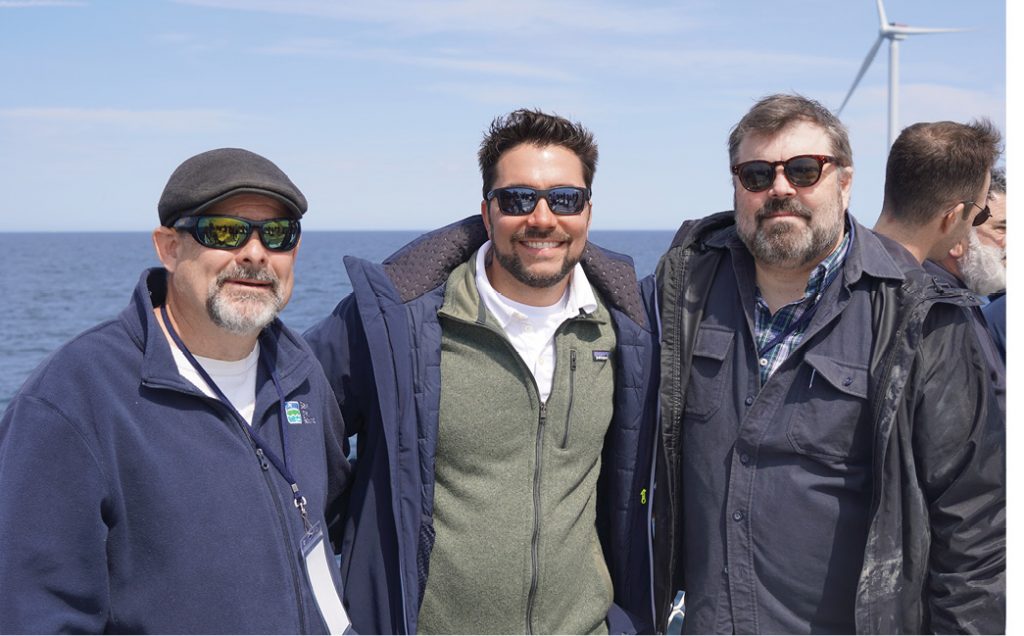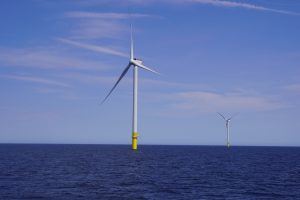From his vantage point on the deck of the Cecelia Anne, the 143-foot catamaran ferrying from New London, CT on a mid-May morning, everything clicked into focus for Charles Rothenberger. As he scanned the steely spread of the open ocean, he realized he was looking at the future.
In the distance were five turbines off Block Island – “America’s Starting Five,” as they’re called by Orsted, the company that installed the first offshore wind farm in the United States in 2016. Further east towards Martha’s Vineyard, the construction of Revolution Wind’s sixty-five turbines was underway. And in front of him, 35 miles east of Montauk Point, awaited his destination: South Fork, the country’s first commercial-scale offshore wind farm, whose twelve turbines began delivering 130 megawatts of energy to Long Island in March, enough to power 70,000 homes and businesses.

Pictured on a recent a recent visit to the South Fork Wind Farm are (l – r) Long Island Soundkeeper Bill Lucey, Connecticut State Representative Brandon Chaffee, and Charles Rothenberger, climate and energy attorney for Save the Sound. © savethesound.org
“You could get a sense of the scale of the industry, how these projects relate to one another,” said Rothenberger, climate and energy attorney for Save the Sound. He was joined on the tour by Save the Sound’s Long Island Soundkeeper Bill Lucey, three state representatives from Connecticut, and staff from Senator Chris Murphy’s office and the Mystic Aquarium. “I was struck by the fact that all these projects are finally being built and will be delivering clean, renewable energy.”
Once the ferry entered the field, Rothenberger watched the turbine blades roll through their slow, steady rotation and found them elegant. The turbines in the South Fork farm stand 788 feet tall, from the surface of the water to tip of a blade at its highest. That’s 2.5 football fields, with a mile of open water between them. Still, there are concerns that wind farms could create obstacles for cargo ships or commercial fishing trawlers.
“It’s understandable that fishermen would be concerned about having more obstacles out at sea. There’s plenty of space for a vessel operating under power to transit through without danger, but if a boat were to lose power, it could drift into a structure,” said Lucey. “Or they might have to pay extra attention when they have fishing gear deployed. Overall, though, the spacing seems quite adequate for commercial fishing in and around the turbines.”
As with any new technology, there are undercurrents of concern about offshore wind. Many are legitimate, and solutions are factored into the planning of these wind farms (Rothenberger serves on a commission that advises the Connecticut Department of Energy and Environmental Protection on standards for projects that avoid, minimize, and mitigate adverse impacts). Some, though, are ghost stories born from an absence of context and understanding.
“It’s problematic. Rhetoric has an impact, and sometimes there are people playing fast and loose with the facts,” said Rothenberger. One common misunderstanding is that there isn’t always enough wind to generate energy. It’s true, but it misses the full picture. “Offshore wind generates the most energy at night and during the winter – the exact times that solar is generating the least,” said Rothenberger. “That’s the brilliance of offshore wind being part of the overall energy mix.” Then there’s the whales. Last summer, there was speculation about whether stranded whales had become disoriented by the sonar being used to explore the ocean floor as potential sites for wind towers or cable. But that sonar is considerably less powerful than the kind used in oil and gas seismic exploration, which is known to affect whales.
The potential issue with whales is the noise generated by pile-driving when setting the foundation. But seasonal restrictions have been established to avoid that kind of construction when right whales have historically been sighted in particular areas. There are other potential impacts that Lucey would like to see studied. He is most curious to see whether the structures will attract predators that could impact the traditional nursing grounds of Atlantic cod.

“They attract fish, like the oil derricks in the Gulf of Mexico that are famous for spearfishing or the old Tappan Zee Bridge put in the water to attract fish,” said Lucey. “From a sportfishing perspective, it could be an enhancement. Ecologically speaking, we need to look at it more, and the wind companies have shown a willingness to do so.”
The challenge that lies ahead, as offshore wind energy begins to come online in New York and New England is maximizing impact on energy production and minimizing impact on the ocean ecology and the economies dependent on those waters.
“Our position has always been that we support the environmentally responsible development of offshore wind. The companies are cognizant of the potential for conflicts, and they are taking every reasonable step to avoid them,” said Rothenberger. “We have to remember that these renewable resources are absolutely essential. Doing nothing is not an option.” ■
Save the Sound works across the Long Island Sound region to protect the Sound and its rivers, fight climate change, save endangered lands, and work with nature to restore ecosystems. More info at savethesound.org.




